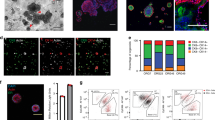Abstract
Mouse mammary glands respond to growth promoting hormones in organ culture. In the presence of insulin, prolactin, aldostrone, and hydrocortisone, the glands exhibit extensive proliferation within 10 days of culture mimicking the mammary alveolar structures observed during pregnancy. However withdrawal of prolactin and steroids from the medium for an additional 14 days results in the disintegration of the alveolar structures resembling the mammary morphology observed during the involution stage. During the growth promoting phase if the glands are exposed to 7, 12, dimethylbenz(a)anthracene (DMBA) for 24 hours and cultured through the entire 24 days of culture period, they develop precancerous lesions. This model is highly reproducible and extensively utilized to evaluate efficacy of potential chemopreventive agents against carcinogen-induced mammary lesions.
Similar content being viewed by others
References
Nandi S (1958). Endocrine control of mammary gland development and function in the C3H/He crgl mouse. J Natl Cancer Inst 21: 1039–1063.
Rosen JM, Humphreys R, Krnack S, Juo P, Raught B (1994). The regulation of mammary gland development by hormones, growth factors and oncogenes. Prog Clin Biol Res 387: 95–111.
Ip MM, Darcey KM (1996). Three dimensional mammary primary culture model systems. J Mam Gland Biol and Neopl 1: 91–110.
Mehta RG, Banerjee MR (1975). Hormonal regulation of marcomolecular biosynthesis during lobulo-alveolar development of mouse mammary gland in organ culture. Acta Endocrinol 80: 501–517.
Banerjee MR, Antoniou M (1984). Serum free culture of the isolated whole mammary organ of the mouse: a model for study of differentiation and carcinogenesis. In: Barnes DW, Sirbasku A, Sato GH (eds), Methods for serum free culture of cells of the endocrine origin. New York: Alan R Liss, pp 143–149.
Ichinose RR, Nandi S (1966). Influence of hormones on lobulo-alveolar differentiation of mouse mammary gland in vitro. J Endocrinol 35: 331–340.
Ganguly R, Mehta NM, Ganguly N, Banerjee MR (1980). Glucocorticoid modulation of casein gene transcription in mouse mammary gland. Proc Natl Acad Sci (USA) 76: 6466–6470.
Tonelli QJ, Sorof S (1980). Epidermal growth factor requirement for development of cultured mammary gland. Nature 285: 250–252.
Lin FK, Banerjee MR, Cump LR (1976). Cell cycle related hormone carcinogen interaction during chemical carcinogen induction of nodule-like mammary lesions in organ culture. Cancer Res 36: 1607–1614.
Mehta RG, Liu J, Constantinou A, Thomas CF, Hawthorne M, You M, Gerhauser C, Pezzuto JM, Moon RC, Moriarty RM (1995). Cancer chemopreventive activity of brassinin, a phytoallexin from cabbage. Carcinogensis 16: 399–404.
Telang NT, Banerjee MR, Iyer AP, Kundu AB (1979). Neoplastic transformation of epithelial cells in whole mammary gland in vitro. Proc Natl Acad Sci (USA) 76: 5886–5890.
Mehta RG, Steele V, Kelloff GJ, Moon C (1991). Influence of thiols and inhibitors of prostaglandin biosynthesis on the carcinogen-induced development of mammary lesions in vitro. Anticancer Res 11: 587–592.
Dickens MS, Custer RF, Sorof S (1979). Retinoid prevents mammary gland transformation by carcinogen hydrocarbon in whole organ culture. Proc Natl Acad Sci (USA) 76: 5891–5895.
Hawthorne M, Singh M, Thompson HT, Steele V, Kelloff GJ, Mehta RG (1996). Induction of DMBA-induced mammary ductal lesions in organ culture: A model for human DCIS. Proc Am Assoc Cancer Res 37: 222.
Steele VE, Sharma S, Mehta RG, Elmore E, Redpath JL, Rudd C, Bahgeri D, Sigman CC, Kelloff GJ (1997). Use of in vitro assays to predict the efficacy of chemopreventive agents in whole animals. J Cell Biochem 26 (suppl): 23–46.
Gerhauser C, Woongchon M, Lee SK, Suh N, Luo Kosmeder J, Luyengi, Fong HS, Kinghorn AD, Moriarty RM, Constantinou A, Mehta RG, Moon RC, Pezzuto JM (1996). Rotenoids mediate potent cancer chemopreventive activity through transcriptional regulation of ornithine decarboxylase. Nature Medicine 1: 260–266.
Mehta RG, Hultin TA, Moon C (1988). Metabolism of N-[4-hydroxyphenyl] retinamide by mammary gland organ culture. Biochem J 256: 579–584.
Hultin TA, May CM, Moon RC (1986). N-[4-hydroxyphenyl] retinamide pharmacokinetics in female rats and mice. Drug Metab Disp 14: 714–717.
Mehta RG, Moon C, Hawthorne M, Formelli F, Costa A (1991). Distribution of fenretinide in the mammary gland of breast cancer patients. Eur J Cancer 27: 138–141.
Author information
Authors and Affiliations
Rights and permissions
About this article
Cite this article
Mehta, R.G., Hawthorne, M.E. & Steele, V.E. Induction and prevention of carcinogen-induced precancerous lesions in mouse mammary gland organ culture. Methods Cell Sci 19, 19–24 (1997). https://doi.org/10.1023/A:1009770720081
Issue Date:
DOI: https://doi.org/10.1023/A:1009770720081




